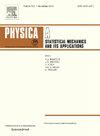Low-temperature states of the Ising ±J model on a square lattice
IF 3.1
3区 物理与天体物理
Q2 PHYSICS, MULTIDISCIPLINARY
Physica A: Statistical Mechanics and its Applications
Pub Date : 2025-06-09
DOI:10.1016/j.physa.2025.130729
引用次数: 0
Abstract
Using the complete enumeration method, we accurately calculated all possible states of the Edwards–Anderson model on a simple square lattice of 8 × 8 spins. The ground state energies of the studied finite-size samples were determined. The macroscopic degeneracy of the ground state in frustrated spin systems arises from the combinatorics of frustrated plaquettes, i.e., the number of ways to place frustrated spin pairs on the lattice. The algorithm for calculating energy, spin excess, and ground state configurations is based on identifying the arrangement of frustrations. The dependence of the ground state spin excess in the Edwards–Anderson model on an external magnetic field has a discrete (step-like, stair-like) character. Critical values of the external magnetic field, at which large peaks in residual entropy occur, were calculated. The nature of these large entropy peaks is explained by the fact that, at certain critical values of the external magnetic field, the sum of several spin configurations with different interaction energies and Zeeman energies, i.e., with different values of spin excess, will have the same total energy. The degeneracy multiplicities of states with the same total energy are summed up at the critical magnetic field value. The areas of existence of low-temperature states have been determined.

方形晶格上Ising±J模型的低温态
利用完全枚举法,我们精确地计算了一个简单的8 × 8自旋方形晶格上Edwards-Anderson模型的所有可能状态。确定了所研究的有限尺寸样品的基态能量。受挫自旋系统中基态的宏观简并源于受挫斑块的组合,即在晶格上放置受挫自旋对的方法的数量。计算能量、自旋过剩和基态构型的算法是基于识别受挫点的排列。爱德华兹-安德森模型中基态自旋过剩对外部磁场的依赖具有离散(阶梯状,阶梯状)特征。计算了残熵出现较大峰值的外磁场临界值。这些大熵峰的性质可以用以下事实来解释:在一定的外磁场临界值下,具有不同相互作用能和塞曼能的几个自旋构型的和,即具有不同的自旋过剩值,将具有相同的总能量。在临界磁场值处,总结了具有相同总能量的态的简并多重度。低温态的存在区域已经确定。
本文章由计算机程序翻译,如有差异,请以英文原文为准。
求助全文
约1分钟内获得全文
求助全文
来源期刊
CiteScore
7.20
自引率
9.10%
发文量
852
审稿时长
6.6 months
期刊介绍:
Physica A: Statistical Mechanics and its Applications
Recognized by the European Physical Society
Physica A publishes research in the field of statistical mechanics and its applications.
Statistical mechanics sets out to explain the behaviour of macroscopic systems by studying the statistical properties of their microscopic constituents.
Applications of the techniques of statistical mechanics are widespread, and include: applications to physical systems such as solids, liquids and gases; applications to chemical and biological systems (colloids, interfaces, complex fluids, polymers and biopolymers, cell physics); and other interdisciplinary applications to for instance biological, economical and sociological systems.

 求助内容:
求助内容: 应助结果提醒方式:
应助结果提醒方式:


